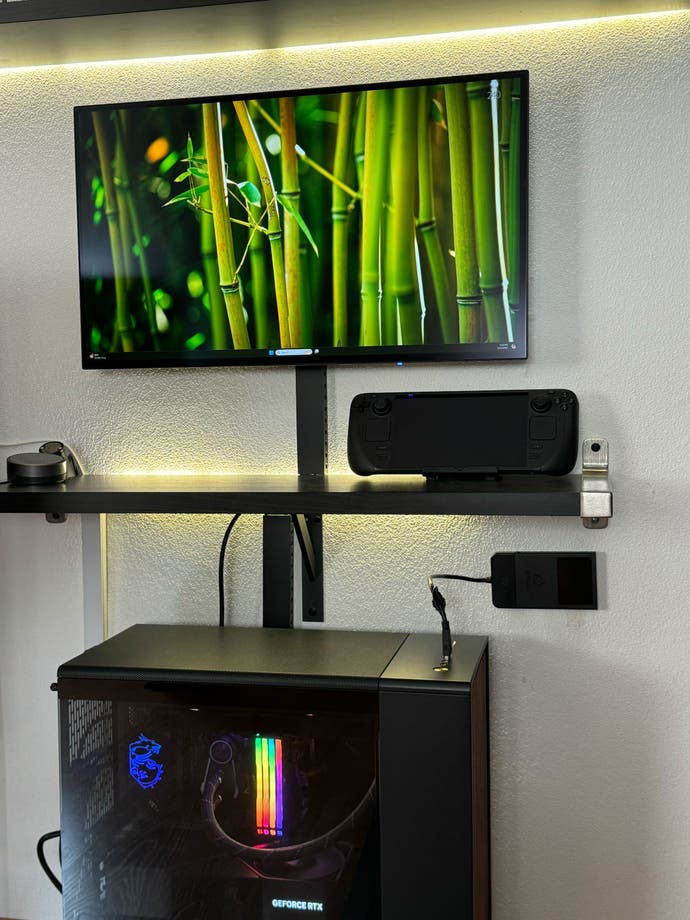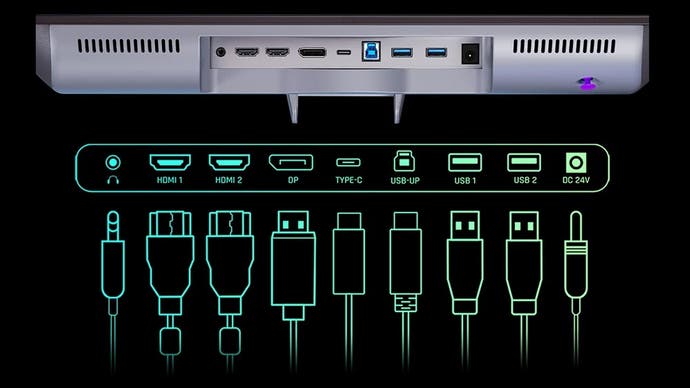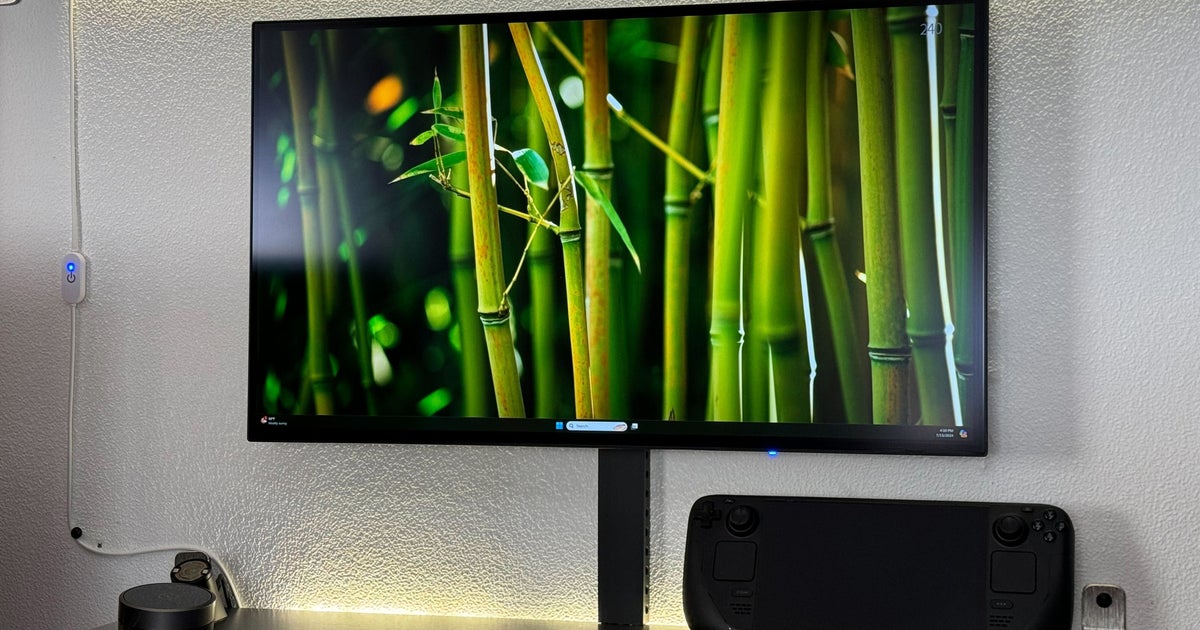OLED technology has continued to gain momentum in recent years with its superior black levels, contrast, motion resolution and vibrancy. Yet, in the PC space, it’s only recently that actual OLED monitors have started to become mainstream. There’s just one issue: OLED monitors tend to cost significantly more than competing LCD monitors and primarily target larger sizes.
Enter the KTC G27P6: a 27-inch 1440p monitor with a maximum refresh rate of 240Hz. This same panel is also used in monitors from Corsair and LG itself, with variation largely stemming from price. I’ve been test driving this monitor over the past few months weighing it against other OLED displays in my arsenal. This includes tests featuring static imagery on-screen for lengthy periods of time just to see if it burns in. Along the way, I’ve discovered some interesting benefits that might be worth considering if you’re interested in jumping into the world of OLED.
The first thing to consider is the general landscape for OLED monitors – compared to LCDs, there are fewer variations in size available with OLED technology. There are smaller portable monitors under 20 inches available, though these are largely 60Hz and limited to lower resolutions, and there are larger sizes available starting over 32 inches. While I’m partial to large displays myself, many prefer 27-inch panels and this does have its benefits – especially when it comes to gaming, which I’ll discuss shortly.

The G27P6 carries a $799 MSRP but is currently available for $570/€590, making this one of the lowest-cost dedicated OLED gaming monitors on the market. Most other monitors using this 27-inch OLED panel are priced closer to $1000, for context.
Now, it’s not a cheap monitor by any stretch of the imagination, but it’s an affordable way to get your hands on a very fast OLED monitor. The thing is, when talking about LCDs, low prices are often a red flag, due to low-quality panels and lack of features but with OLED, the panels themselves boast inherent qualities that ensures even the lowest-cost options can look fantastic.
Within the colourful box you’ll find everything you need: an easy-to-use stand with both pivot and height adjustments available, the necessary HDMI and DisplayPort cables, the power cable and the monitor itself. The KTC also offers VESA mounting holes directly on the rear, which I used in my setup pictured in this review. The rear panel also offers multiple inputs: two HDMI 2.0, DisplayPort 1.4, USB-C w/ 65W power delivery, USB-B and 3.5mm audio out. The monitor also houses a pair of speakers which, while certainly nothing impressive, are useful in a pinch.
Aesthetically, the front is completely devoid of any detail identifying the monitor – it’s a thin, black rectangle as you might expect from a thin OLED panel. When mounted, it’s especially sleek as it genuinely looks like a thin, floating display comfortably resting on your wall. The rear of the unit is perhaps less attractive but does the job. This is only something to consider if your monitor is facing the room.
Along the bottom right edge, you’ll find a single LED that illuminates based on the monitor’s status and, behind that, a small joystick used to access the monitors’ GUI. The menu itself is simple and responsive with plenty of adjustment options. The main menu reveals the current refresh rate, whether adaptive sync and HDR are active and the current resolution. Sadly, there is no support for anything like black frame insertion but if you’re able to hit higher frame-rates, it becomes less necessary.
Once you sit down to use it, the KTC boasts a very different sort of presentation versus other OLEDs I commonly use and that does have an impact on the experience. Firstly, the screen material is completely matte in contrast to the glossy panels you typically find on OLED displays. I’m not always a big fan of matte screens but, in this case, the combination of high-contrast OLED with the matte finish produces a mighty impressive result… so much so that I found myself wanting a matte finish on the 42-inch LG C2 OLED I use as my primary monitor. It cuts down on reflections, yet still appears vibrant.

Secondly, there’s the 240Hz refresh rate. I’ve used plenty of high refresh rate LCD monitors, but this is my first experience with an OLED panel capable of more than 120Hz and it is truly jaw dropping. The sheer fluidity and speed are impressive, and it also helps explain the lower 2560×1440 resolution. Hitting 240fps at native 4K is extremely difficult, but at 1440p it’s quite doable on a powerful PC, especially when deploying features such as frame generation. Furthermore, with a 27-inch diagonal, the 1440p remains sharp and clear, boasting around 108 pixels per inch – comparable to the 104PPI you get with a 42-inch 4K display. 27 inches is the sweet spot for this specific resolution, I think.
Seriously, going back to favorites like Doom Eternal at a full 240 frames per second coupled with the vibrancy of an OLED panel, it’s genuinely striking. At 240fps, persistence blur is also cut down tremendously, lending the monitor a level of motion clarity that satisfied me even without relying on black frame insertion, a technique designed to eliminate persistence blur.

However, it’s more the versatility that makes this monitor a true winner in my book. I currently use it in three ways. Firstly, it serves as a secondary monitor on my PC which I can use for any number of tasks, or games if I desire 240fps action. Secondly, it accepts 3840×2160 inputs at 60Hz even though it’s a 1440p panel, meaning that it works great for playing console games while capturing. This compatibility is key for people that use their primary monitors for both PC and console. The downscaling quality looks great. Lastly, using the 65W USB-C connector, the KTC can both charge the Steam Deck and display its video at 1440p60 without issue. Thus, it makes a greater display for using the Steam Deck, especially if you delve into desktop mode. It’s simple to swap between these different use cases and the whole thing just works great.
So, what about the nature of its panel itself? Things such as HDR performance, input lag and handling of burn-in? Well, firstly, the monitor held up over the last four months without any signs of actual burn-in or even image retention. I would sometimes just turn it on and let it sit at the Steam Deck’s main menu for hours on end while I worked. It proved to be no issue.
HDR is next and this one is interesting. When configured properly, the KTC delivers a vibrant HDR presentation with small highlights reaching nearly 900 nits. For a monitor, that excellent performance brings HDR content to life. There’s a caveat, however, with the monitor’s configuration and tone mapping features.
Firstly, when you enable HDR, you lose access to things such as brightness and contrast adjustments. Instead, you have two modes: HDR Standard and HDR Cinema. I recommend Cinema for the best picture quality but, even then, the monitor’s performance is reliant on the content. There is no equivalent to dynamic tone mapping here, or any other option to boost overall brightness levels. Instead, all of this must be handled on the software side. Most of the HDR games I tested worked great, including AutoHDR titles, but some lack the ability to adjust settings – leading to a somewhat dimmer picture outside of highlights. Thus, you’ll want to make sure your PC or console is configured properly if you want to use HDR.
Next, I wanted to mention input lag. The monitor features a ‘low input lag’ option in the menu and you’ll want to enable this. I noticed no degradation in picture quality but a huge improvement to response times. When displaying a native 240Hz image at 1440p, you can achieve results below 3ms, which is extremely quick. If you drop to 60Hz content, however, I found that this increased latency to 13ms – still less than one frame, but slower. If you disable low input latency mode, however, that same 60Hz signal rises to almost 33ms instead, which is too slow. Make sure you enable this option!
Still, despite these drawbacks, the overall quality of the display impressed me. It’s flexible, offers excellent image quality and a non-intrusive form-factor with minimal RGB lighting, and boasts that super-smooth 240Hz action. Honestly, I feel like we’ve finally reached the point where OLED monitors can be enjoyed by just about anyone. There’s a lot to love here in terms of picture quality and performance, hence I fully recommend it!



